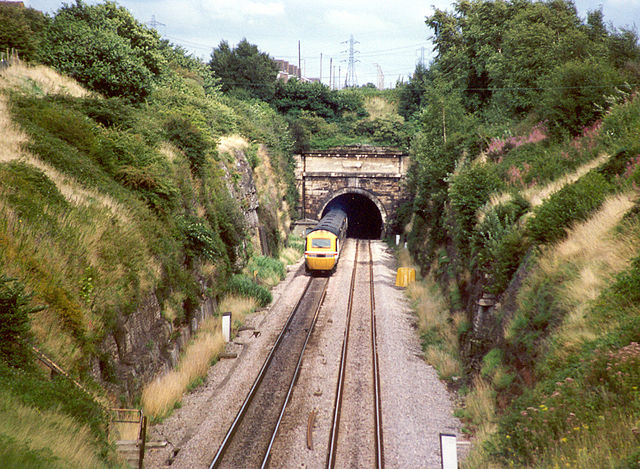The Severn Tunnel is a railway tunnel in the United Kingdom, linking South Gloucestershire in the west of England to Monmouthshire in south Wales under the estuary of the River Severn.
Built by the Great Western Railway (GWR) between 1873 and 1886, it is 4 miles 624 yd (7,008 m) long, and was the longest mainline railway tunnel within the UK for well over 100 years until the two major High Speed 1 tunnels (London East and West) were opened as part of the CTRL in November 2007. Only 2¼ miles (3.62 km) of the tunnel are actually under the river.
Construction
Prior to the building of the tunnel, communications between the Bristol area and South Wales were primarily by boat. With the coming of the railway, services were forced to either take a long detour via Gloucester, or to transfer their passengers and cargo onto a ferry. The GWR proposed to drive a tunnel under “The Shoots”, a relatively narrow but unusually deep section of the estuary. This meant steep gradients by railway standards in order to reach the required depth.
Work on the tunnel began in March 1873, and proceeded gradually through the 1870s. As Thomas Walker notes in his book, GWR had expected the critical part of the work to be the tunnelling under the deep-water channel of the Shoots. However, the builders” real difficulties began in October 1879. At this stage, when only 130 yards (119 m) remained separating the main tunnel heading being driven from the Welsh side, and the shorter Gloucestershire heading, the workings were inundated, from a large fresh-water source (“The Great Spring”) tapped by the heading being driven inland on the Welsh side.
Thomas A. Walker was the contractor entrusted by the chief GWR engineer Sir John Hawkshaw with rescuing and completing the tunnel after the 1879 flooding. Holding the Great Spring in check required the installation of greatly increased pumping facilities, and a diver had to be sent down a shaft and 300 m along the tunnel heading to close a door in the workings and seal off the waters. This troublesome task was finally achieved in November 1880 by lead diver Alexander Lambert using Henry Fluess” new self contained breathing apparatus, but work in the area of the Great Spring was unable to continue until January 1881 when the Great Spring was temporarily sealed off. Work was later disrupted in 1883 by further flooding from the Great Spring, and again Lambert managed to save the day. Additional mishaps afflicting the workings included a large tidal wave and a breakthrough of the bed of a pool (the “Salmon Pool”) on the English side. In the intervening period the Severn Railway Bridge from Sharpness to Lydney was opened.
The tunnel was completed during 1885 and a goods train passed through it on January 9, 1886, but regular services had to wait until the pumping systems were complete. The tunnel opened to goods trains in September and to passenger traffic in December 1886, nearly 14 years after work had started. Fixed steam engines pumped out the Great Spring and other sources of water until the 1960s, when they were replaced by electrically powered pumps.
In the 1930s the availability of the reliable fresh water supply from the Great Spring led to the choice of site for the Royal Navy Propellant Factory, Caerwent.
World War II
During World War II, a Great Western Railway passenger train was pursued by a German aircraft along the main line to Wales. Reaching speeds estimated at 90mph (well above the wartime restrictions in place) the train successfully escaped into the tunnel and stopped beneath the river until the driver judged that the danger had passed. The train was struck by several bullets during the chase but there were no serious injuries.
Present Day
The Second Road Crossing (usually but slightly misleadingly called the Second Severn Crossing), crosses over the tunnel on a “ground level bridge” on the English side, (near the Salmon Pool), supported in such a way that no load is imposed on the tunnel. The opportunity was taken to renew the concrete cap above the tunnel in the Salmon Pool during bridge-construction.
There is also a second tunnel under the river just upstream near this point, carrying a high-capacity electricity cable (SuperGrid) under the river, complementing the earlier high-capacity Aust Severn Powerline Crossing, which is carried over the river by pylons just downstream of the original Severn Bridge. Both electricity links were originally commissioned by the CEGB.
As the tunnel has aged, every Sunday the tunnel is closed to allow teams of engineers in to carry out vital work to ensure the safety of the passengers that use it. On several occasions, it has closed immediately after drivers of various trains have reported hearing their trains hit items on the track.
The tunnel is severely congested, and freight from South Wales ports (especially Newport) to England is often routed via Gloucester.
As part of the 21st-century modernisation of the Great Western Main Line, the tunnel was prepared for electrification. The tunnel has good clearances and is relatively easy to electrify, although due to its age the seepage of water from above in some areas provides an engineering challenge. The options of using normal tunnel electrification equipment or a covered solid beam technology were considered and the decision was made to use solid beam. An aluminium conductor rail holds the copper cable for the length of the tunnel; the cable is not under tension. A six-week blockade of the tunnel started on 12 September 2016. During this period alternative means of travel were either a longer train journey via Gloucester or a bus service between Severn Tunnel Junction and Bristol Parkway. Also for this period, and possibly beyond, there were direct flights between Cardiff and London City Airport. The tunnel reopened on 22 October 2016.
Discover more from LandmarkLocation.com
Subscribe to get the latest posts sent to your email.


